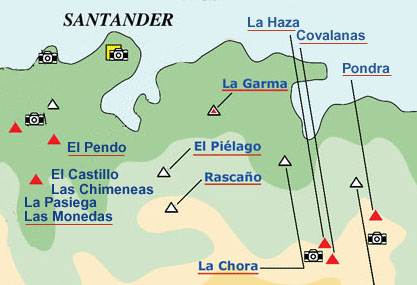Photo Archives: Paleolithic Art in Northern Spain
La Haza
Preview Edition
- 12 photos(about1280x1000,1470x980/JPEG) .
- Commentary by César González Sainz & Roberto Cacho Toca, Univ. of Cantabria.
- Royality Free for private and educational use.
In this downloadable photo archives are contained 9 photos of Paleolithic cave art of La Haza cave with the archeological data and commentary as shown in this preview pages. Only the small sized reference images and a part of commentary are shown in this preview edition, but if you are interested to see more and to use these photos, please go to Kagi store and purchase the data package. Once payment has been made at the Kagi store, you will receive an e-mail containing the URL to download the data package. All photos that are contained in this package are ROYALITY FREE for private and educational use.
 La Haza
La Haza
Cueva de La Haza is located at the foot of the hill Monte Pando, 160m above sea level, on the right-hand bank of the River Calera, very near the Cantabrian town of Ramales de la Victoria. This hill has numerous caves, especially Covalanas, with an important group of Paleolithic paintings, and El Mirón, where an archaeological dig is examining levels that go from at least the Mousterian to the Bronze Age, in a cave which must have been the main habitation site in the area during the Upper Paleolithic.
The caves of Monte Pando are in a strategic geographical position. Apart from being a place with plentiful hunting and fishing, this area controls a natural gap for communication between the coastal strip and the high summer pastures, and beyond those, the Meseta. This route must have often been traveled, at least as far as the glaciers allowed, and not only by the Paleolithic human populations, but also by herds of ungulates. Cueva de La Haza is positioned precisely next to an old road which, in historical times, was the traditional way of communication between the Cantabrian coast and the Meseta in the south. During the Upper Paleolithic, it could have been used in the same way, at least in more temperate phases, uniting the Paleolithic sites in the Asón valley with a number of caves in the province of Burgos, like La Palomera in the Ojo Güareña cave system, Penches and even Atapuerca, all of which have Paleolithic cave art.
---------------------------------------
[References]
Moure Romanillo, A.; González Sainz, C.; González Morales, M. 1991. Las cuevas de Ramales de la Victoria, Cantabria. Universidad de Cantabria, Santander.
|
Photographed by Takeo Fukazawa & Co-Project Team of Texnai Inc. and the University of Cantabria
Commentary by César González Sainz & Roberto Cacho Toca, Univ. of Cantabria
Texnai Inc.:
2-1, Udagawa-cho, Shibuya-ku, Tokyo, Japan. Tel:03-3464-6927 Fax:03-3476-2372
e-mail:info@texnai.co.jp
Copyright reserved by Takeo Fukazawa &Texnai, Inc., University of Cantabria, IPA
|
|